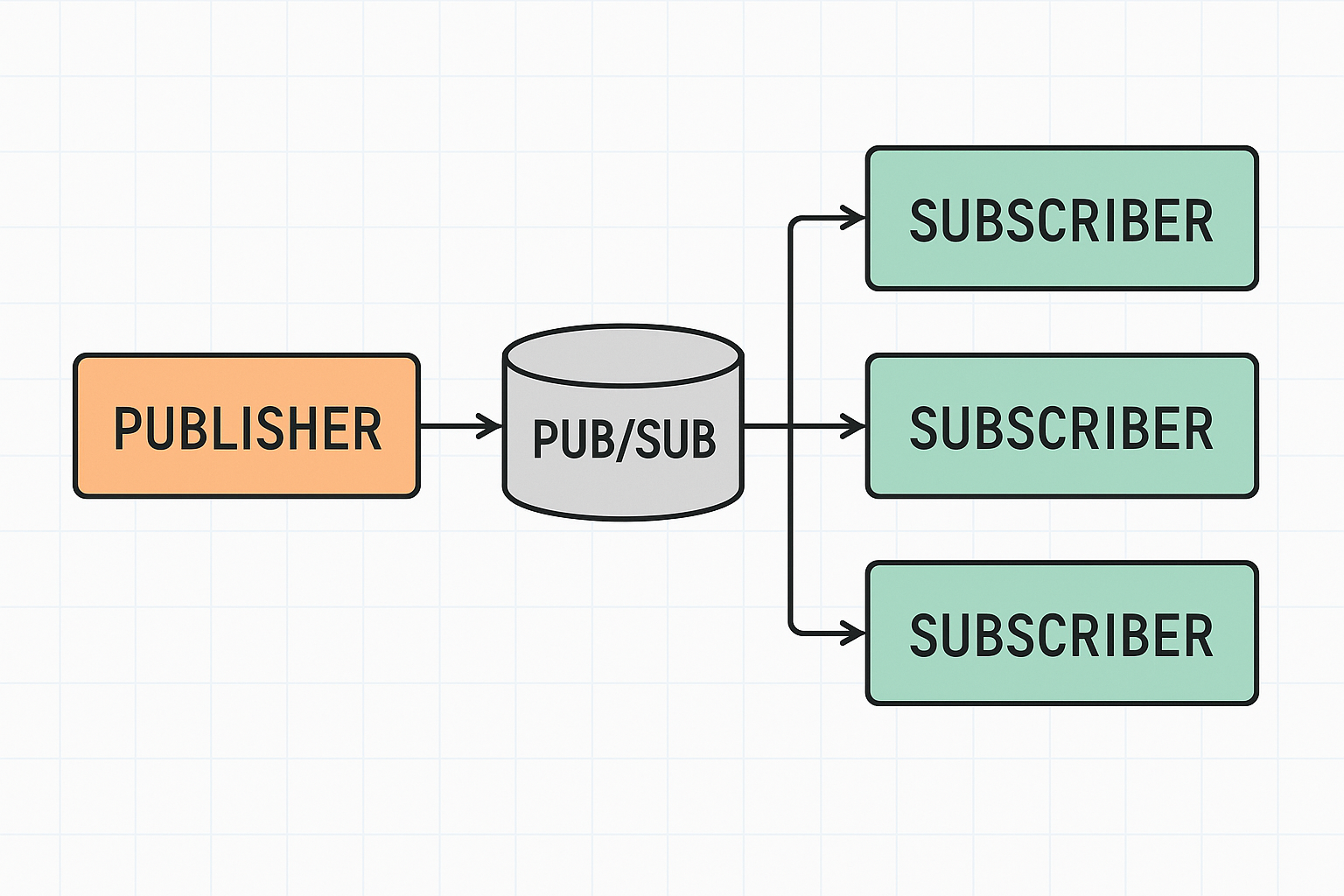Publisher Subscriber Architecture Design Pattern
Publisher Subscriber (Pub/Sub) is a popular architectural design pattern used in distributed systems to allow different parts of a system to communicate with each other in a flexible and efficient way. At its core, it enables components to exchange messages without needing to know anything about each other—this is known as decoupling, and it’s one of the biggest strengths of the Pub/Sub model.
Think of it like a radio station: the broadcaster (publisher) sends out a signal, and anyone who tunes into that frequency (subscribers) can receive it. The broadcaster doesn’t know who’s listening, and the listeners don’t need to know who the broadcaster is—they’re just interested in the content. In the same way, a system using Pub/Sub lets services publish messages to a “channel” or “topic,” and any service that subscribes to that topic will receive the message. This separation makes systems more flexible and easier to manage as they grow.
Pub/Sub builds on earlier messaging concepts like message queues and event brokers, but it introduces more scalability and flexibility. These features became especially important as computing environments evolved. In the early days—before the widespread use of the Internet—systems were relatively static. They were built with fixed resources and didn’t need to change much over time. But with the rise of the web, mobile apps, and the explosion of Internet of Things (IoT) devices, systems needed to adapt and grow dynamically, sometimes scaling up or down in real-time to handle varying loads.
That’s where Pub/Sub really shines. Its loosely coupled design means you can add, remove, or change parts of your system without breaking everything else. You can easily scale certain components to handle more traffic without touching the rest of the system. Because the communication is asynchronous, messages can be processed independently and at different times, which is ideal for high-performance, scalable applications.
In short, Pub/Sub is a modern, scalable way to manage communication in complex systems. It keeps things flexible, helps systems grow efficiently, and reduces the burden on individual components by simplifying how they exchange information.

-
A Publisher sends messages to a Topic.
-
A Broker (or Message Bus) manages the topics and distributes messages.
-
Multiple Subscribers listen to that topic and receive the messages.

Pub/sub messaging is like a group text for software systems—but smarter and more organized. Instead of one app sending messages directly to another, apps can “publish” messages to a topic, and other apps can “subscribe” to that topic to get those messages.
This model is super helpful in cloud applications, where everything is broken down into smaller, independent pieces (called microservices). These pieces need to talk to each other, but we don’t want them tightly connected, because that makes the system harder to scale or update.
With pub/sub, one part of your system can send out a message (like “a new user signed up” or “a file was uploaded”) without needing to know who’s listening. Whoever’s interested in that kind of event just subscribes and gets notified instantly.
It’s asynchronous, meaning the sender and receiver don’t need to wait for each other. It’s also reliable and scalable, which is key when you’re dealing with modern apps that might be handling thousands (or millions) of events per second.
Why use Publisher/Subscriber? What’s in it for you?
1. Loose coupling = Less stress
With pub/sub, different parts of your system don’t need to know about each other. The publisher just sends a message, and whoever’s interested will get it. This means you can update or change one part without breaking the others. It keeps things flexible and easier to manage.
2. Scales like a champ
As your app grows, pub/sub can handle more messages and more subscribers without getting overwhelmed. You can have 10 or 10,000 services listening in, and it’ll still work smoothly.
3. Real-time updates
Need things to happen right away? Pub/sub is great for instant notifications—like sending a text when your food order is ready or updating a dashboard the moment new data comes in.
4. Better performance with async communication
Since publishers and subscribers don’t have to wait on each other, your system stays fast and responsive. It’s like leaving a voicemail instead of waiting on hold.
5. Easier to add new features
Want to add a new service that listens to an existing event (like logging, alerts, or analytics)? No problem. Just subscribe to the topic—no need to touch the existing code.
6. Great for complex systems
In modern cloud-based systems, you often have lots of small, independent services. Pub/sub helps them all talk to each other in a clean, organized way—without becoming a tangled mess.
In short, pub/sub helps you build smarter, faster, and more flexible applications that can grow and change without giving you a headache.
Key Features of a Pub/Sub Messaging System
When you build applications using the publish-subscribe (pub/sub) pattern, you’re separating what the app does from how it communicates. That means your app focuses on its job, while the messaging system handles getting messages where they need to go. It acts like a middleman, making sure messages get delivered to the right listeners—without the sender or receiver needing to know about each other.
Here are some key features of a pub/sub messaging system, explained in plain English:
🚀 Push Delivery
As soon as a message is published to a topic, it’s instantly sent to subscribers—no waiting around. It’s like getting a text alert the second something happens. Everything happens asynchronously, so your app keeps moving smoothly.
🌐 Multiple Ways to Deliver Messages
Messages don’t just go one way. A single topic can send messages to all kinds of places—like message queues, serverless functions (like AWS Lambda), web servers, or even email addresses. This makes it super flexible depending on what your app needs.
📣 Fanout (One Message, Many Listeners)
When you publish a message, it can be sent to multiple subscribers at once. This is called fanout—kind of like sending one email to an entire group. Each subscriber can then act on the message in its own way, all happening in parallel.
🔍 Filtering
Subscribers don’t have to get every message. They can set up filters to only receive what they actually care about. For example, a service might only want “error” events and ignore everything else.
🔄 Multiplexing (Publishers Can Listen Too)
Sometimes, a service can both send and receive messages. This is called multiplexing. It lets parts of your system talk to each other in a more dynamic and connected way—helpful for building more complex, responsive apps.
In short, pub/sub messaging helps you build systems that are flexible, fast, and built for scale—all while keeping your code clean and your services loosely connected.
Would you like me to reword this into a visual infographic or bullet-style summary for a presentation?


Leave a Reply